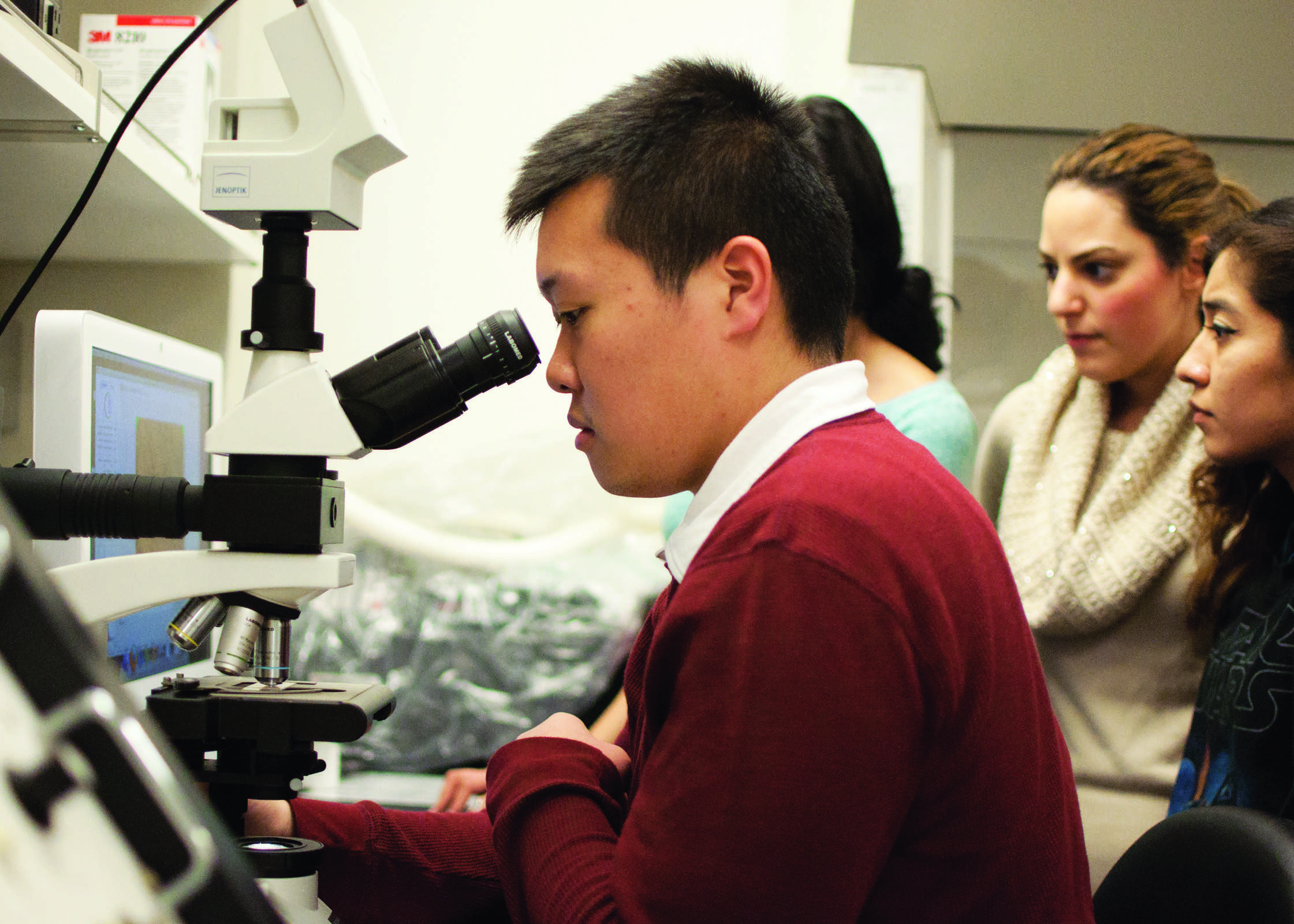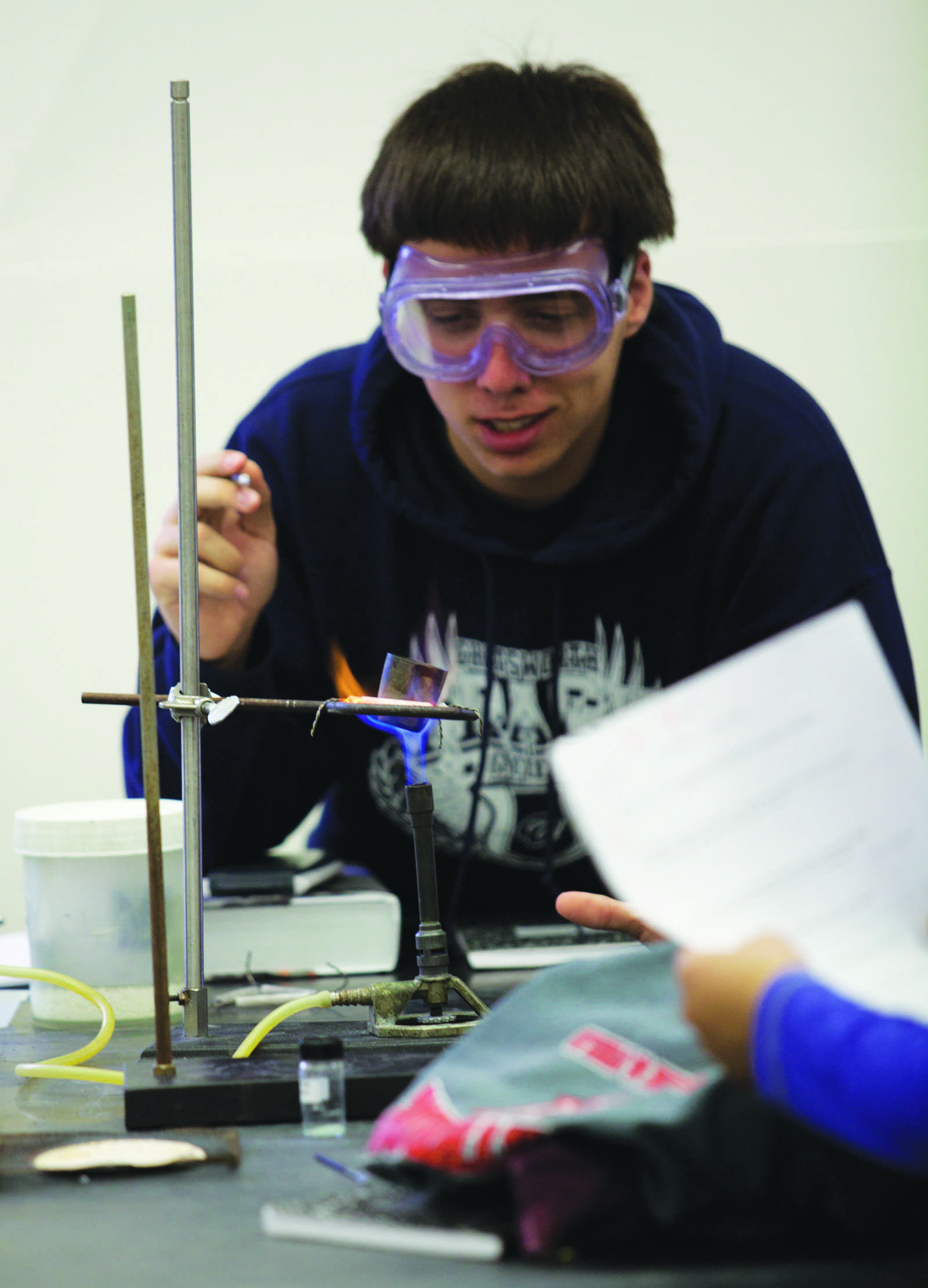
While most students hurry from class to class, a small group is working on projects for NASA and the U.S. Air Force in an inconspicuous lab located on the first floor of Jacaranda Hall. A collection of tube benders, a plasma cutter, milling machines, and hydraulic shears fill the room.
Unmanned aerial vehicles and Multi-Aircraft Control System (MACS)
Among all of the Haas lab’s metal and office furniture, students like 31-year-old mechanical engineering major Christopher Lee, sit entranced by the slow glow of light emanating from their computer monitors. The lab itself was named after CSUN alumn Gene Haas in 1998, providing students like Lee with state-of-the-art machinery in order to manufacture engine components.
Lee is a graduate student working on a research project with NASA involving the use of unmanned aerial vehicles (UAV) for civil purposes.
“The (Federal Aviation Administration) doesn’t allow them to fly in the national airspace because the FAA hasn’t made rules and regulations for allowing UAVs to fly in the national airspace,” Lee said.
Companies like Google, Amazon and the United Parcel Service (UPS) have recently made headlines for testing drones they hope to use for domestic deliveries.
“The commercial use of drones is an interesting technology and we’ll continue to evaluate it,” a UPS spokesman said to theverge.com. “ UPS invests more in technology than any other company in the delivery business, and we’re always planning for the future.”
The problem with civil drones is not only that they haven’t been regulated yet, but that air traffic is predicted to increase in the future.
According to Lee, the number of aircrafts in the nation’s airspace is predicted to triple by 2050, which could cause longer wait times and more expensive flights. UAV delivery services could also present safety issues.
To help the government formulate regulations for the drones, Lee is working with NASA on a simulator called Project Condor.
The simulator is a computer program that mimics control stations, multiple UAVs and air traffic.
“This is a major, major project,” Lee said.
The research started in September of 2013. Ultimately, Lee hopes to produce something that can be used by the government to help draft drone laws and by the public.
“We really want this to be used for civil purposes, to be able to integrate UAVs into the national airspace,” said Jeffrey Limbacher, lab manager.
Limbacher is working alongside Lee with a similar computer program.
MACS, the acronym for Multi-Aircraft Control System, is a NASA software program that simulates air traffic over the US.
Limbacher is using it to research multi-UAV control.
“We go up to Moffett Airfield in Mountain View California,” Limbacher said. “We have an Army group that we talk to.”
He also hopes to be able to use his program and research for government and cilivian applications.
Integrated Collision Avoidance System
Another research project being conducted on campus involves psychology and Air Force pilots.
Christina Garcia, a senior in psychology, is doing a case study looking at ground collision prevention systems in planes and why pilots rely on them so much.
It’s common for Air Force pilots to lose consciousness or become disoriented because of g-force while flying and crash their planes.
“Who’s controlling the plane if you pass out?” Garcia said.
Because of this, the government designed a safety feature in planes which pulls the aircraft up if it gets too close to the ground or another plane.
“Because there were so many lives and planes being lost from this, they came up with this system,” Garcia said.
ICAS, or Integrated Collision Avoidance System, was designed to be an emergency safety feature. Garcia and her partner are interviewing various groups of people involved in the making, installation and use of ICAS to see why pilots rely on it.
The students in both Project Condor and the ICAS study routinely go to military bases to meet with government officials.
“We’re researching the influence of culture,” said Dr. Nhut Ho, professor of mechanical engineering, who oversees the research students.

The study has been going for two years and Garcia has been involved since August 2013. Various students have worked on the research over the last few years with a graduate student moving on to work with NASA.
Garcia hopes the study will be done at the end of the semester.
Grants and other research
On Feb.14, CSUN held its annual Student Research and Creative Works Symposium.
At the symposium students from nine departments across the academic spectrum were given ten minutes for an oral or poster presentation on the research they are doing.
Presentations included “Sex and the Married John: A Profile of Male Sexual Behaviors with Street Prostitutes” by Karen Sabbah from the sociology department, and “Crossing Number of a Cylindrical Drawing of a Complete Bipartite Graph” by Athena Sparks in the mathematics department.
Prizes were given out by a panel of judges in both graduate and undergraduate categories. The top ten presentations will go to the 28th Annual California State University Student Research Competition at CSU East Bay on May 2 and 3.
The primary reason for the event, however, is to share some of the research being done on campus with the community.
The symposium was an example of CSUN’s history of involvement in research projects.
In 2013, graduate student Michael Schram was awarded a $3,000 grant from the CSU Council on Ocean Affairs, Science and Technology (COAST) so he could research the role sex-selective fishing plays on sex-changing fish.
Schram was one of 32 students picked to receive part of the $85,000 grant.
In 2011, Physics professor Yohannes Shiferaw was given $76,000 a year for four years by the American Heart Association to study heart attacks.
Since then, Shiferaw has published several articles about his research in scholarly journals.
CSUN’s Oviatt Library is also home to one of the largest resources for sex and gender studies in the US.
“There are three places for anyone that’s serious about transgendered research in this country. The Kinsey Institute, the University of Michigan and CSUN,” said Philosophy professor Dr. C. Jacob Hale in a 2005 Sundial article.
The collection started in 1973 when history professor Vern Bullough donated his personal collection of research material to the Oviatt. Bullough also started the CSUN Center for Sex and Gender Research in the ‘70s.
Many people might be surprised to learn so much research is going on at CSUN because it’s not publicized the way that other departments and groups are.
Garcia only found out about the case study and the opportunity for students to join the project, when she got a mass email from the psychology department.
Many people might also be surprised to learn that so much high-profile research is being done on campus.
“Our work, to a large extent, is based on work with federal agencies,” Ho said. “We’re a very multidisciplinary lab: engineering, computers, psychology — everything.”
Whether it’s in the field of math, science or anything else, chances are there’s research being done on it at CSUN.